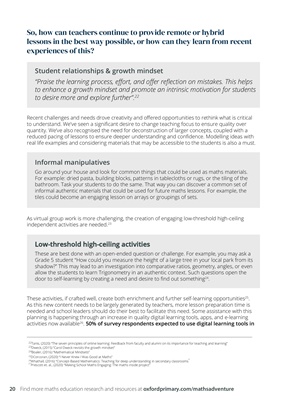
Find more maths education research and resources at oxfordprimary.com/mathsadventure
20
As virtual group work is more challenging, the creation of engaging low-threshold high-ceiling
independent activities are needed.23
Low-threshold high-ceiling activities
These are best done with an open-ended question or challenge. For example, you may ask a
Grade 5 student "How could you measure the height of a large tree in your local park from its
shadow?" This may lead to an investigation into comparative ratios, geometry, angles, or even
allow the students to learn Trigonometry in an authentic context. Such questions open the
door to self-learning by creating a need and desire to find out something24.
These activities, if crafted well, create both enrichment and further self-learning opportunities25.
As this new content needs to be largely generated by teachers, more lesson preparation time is
needed and school leaders should do their best to facilitate this need. Some assistance with this
planning is happening through an increase in quality digital learning tools, apps, and e-learning
activities now available26. 50% of survey respondents expected to use digital learning tools in
22Tanis, (2020) "The seven principles of online learning: Feedback from faculty and alumni on its importance for teaching and learning"
23Dweck, (2015) "Carol Dweck revisits the growth mindset"
24Boaler, (2016) "Mathematical Mindsets"
25DCorcoran, (2020) "I Never Knew I Was Good at Maths"
26Whathall, (2016) "Concept-Based Mathematics: Teaching for deep understanding in secondary classrooms"
27
Prescott et. al., (2020) "Making School Maths Engaging: The maths inside project"
So, how can teachers continue to provide remote or hybrid
lessons in the best way possible, or how can they learn from recent
experiences of this?
Student relationships & growth mindset
"Praise the learning process, effort, and offer reflection on mistakes. This helps
to enhance a growth mindset and promote an intrinsic motivation for students
to desire more and explore further".22
Recent challenges and needs drove creativity and offered opportunities to rethink what is critical
to understand. We've seen a significant desire to change teaching focus to ensure quality over
quantity. We've also recognised the need for deconstruction of larger concepts, coupled with a
reduced pacing of lessons to ensure deeper understanding and confidence. Modelling ideas with
real life examples and considering materials that may be accessible to the students is also a must.
Informal manipulatives
Go around your house and look for common things that could be used as maths materials.
For example: dried pasta, building blocks, patterns in tablecloths or rugs, or the tiling of the
bathroom. Task your students to do the same. That way you can discover a common set of
informal authentic materials that could be used for future maths lessons. For example, the
tiles could become an engaging lesson on arrays or groupings of sets.